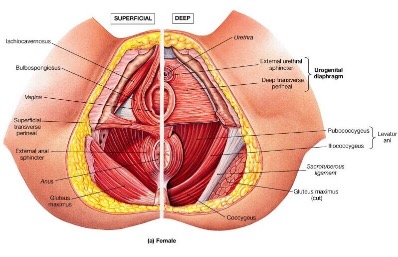
What does hip pain and episiotomy surgeries have in common?
The answer is the superficial perineal layer of the pelvic floor, specifically the transverse perineal muscle.
If you look at the picture above you can see that the transverse perineal muscle attaches itself to the ischial tuberosities (your sit bones). One of its roles is to support the perineum and the sphincters inside of it. During episiotomy surgeries the perineum is cut to allow the baby an easier journey through labour., then the episiotomy is stitched. One of the direct muscles fascially connected to the perineum is the adductors, which lie on the inner thigh. Close your eyes for a second and imagine someone trying to walk with a surgical cut on the inside of one of their upper thighs… Can you imagine a wobbly compensated walk? If this walk were to continue for let's say 6 weeks, (the approximate time a physician will tell you it takes to heal this episiotomy) do you think the body would have now developed a protective walk to help heal the episiotomy? The pelvis usually swings from side to side… wiggling of the bum., but during this protective gait, only one side will swing.
In my clinic I see patients choosing to protect that area by keeping the leg and perineum fascia closed and away from stretching, which results in a movement strategy that avoids placing any tension to the tissues in both the acute phase (useful) and after the healing has long been done. (not so useful)
What then happens is the other joints and muscles now have to pick up the extra work and the hip joint often becomes unbalanced.
How would you know if you have this issue?
-
Check to see what side you have an episiotomy or tear on by visually looking at your perineum. Okay, ladies do not be afraid, it's just anatomy. Find a mirror, it's time to look. if you cannot tell where it is but you know you had one at your delivery… look harder and use your fingers to stretch the area.
-
If you are newly postpartum… Please refrain from this step until your stitches are secure.
- Lay on your back and bring the bottoms of your feet together and let your legs drop open in Froggie style. Take a look to see if one of your legs drops further than the other… Usually, the side of the episiotomy will have some restrictions.
How does a scar cause such trauma so far away from its origin you might ask? In basic terminology scar tissue when it is not moved loses its ability to lay down its collagen fibers properly and results in haphazard tissue formation and weak tissue which further restricts movement and now we have a cycle of this happening which results in fascial restrictions which get larger and larger.
How do We approach care with this @ Pelvic Love Massage Therapy?
Well, first We would like to say that every individual is very different and everyone's healing time is very different. If this is something you think you might like to get treated please make sure you are talking to a professional who deals with the pelvic floor and is qualified for postpartum work.
If immediately postpartum, I would begin with the breath and connection to the pelvic floor with release and contraction. Then move toward muscle treatment through fascial release and joint mobilization of the hip. If this was a chronic issue from earlier in life., I would work on walking properly, pelvis alignment and then muscle treatment through fascial release and joint mobilization.
Don't let your pelvic floor hold you back from moving. Pain-free muscle exploration can help reconnect you to your body and where the restriction might be coming from.
SHARE THIS
COMMENTS
